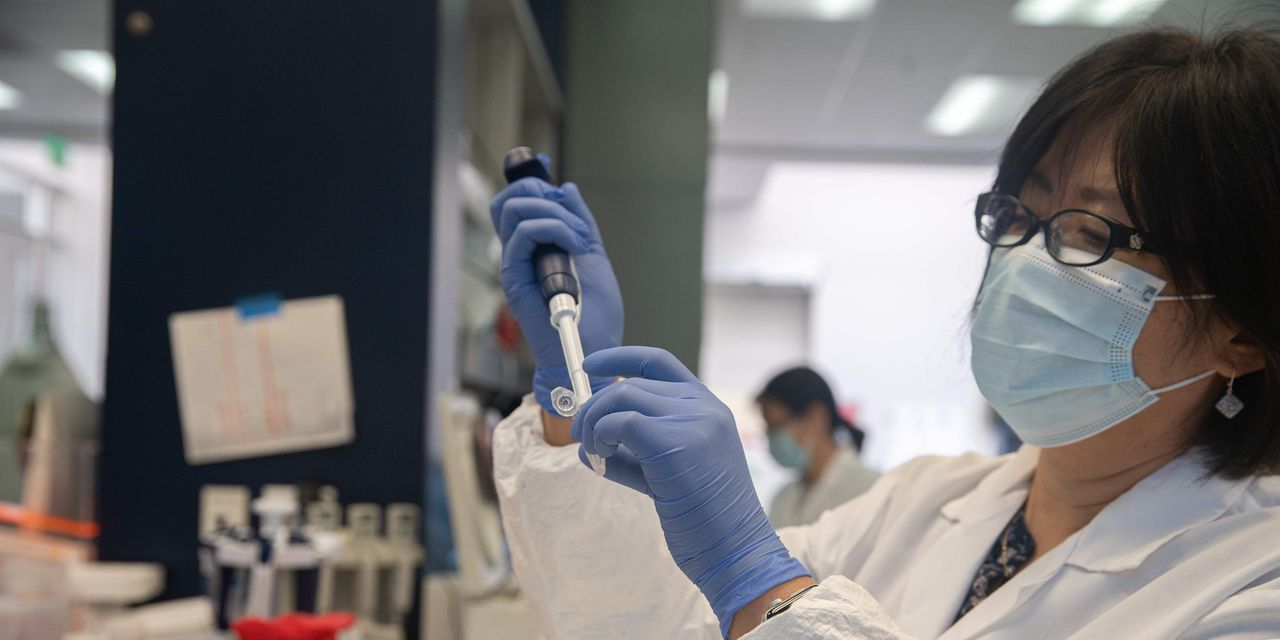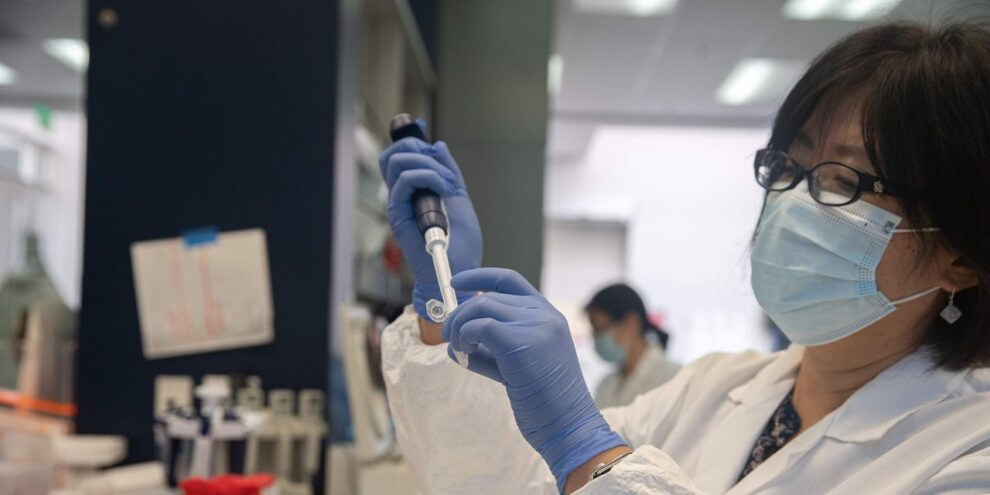
There’s a world of hurt in biotech. It’s in a bear market.
The good news is the pullback offers an chance to get into exciting areas of biotech research like gene editing and oncology at better prices. Some of these names will see buyout pops since they’re now more attractive targets for big pharmaceutical firms.
It makes sense to turn bullish because, big picture, the decline is more about a sentiment shift than a change in fundamentals. Importantly, political risk is minimal even though the Democrats have regained power in Washington, D.C. (More on that in a moment.)
First, about that world of hurt. The SPDR S&P Biotech exchange-traded fund XBI, -0.30% plunged 20% from the early February highs through the end of last week (a bear market). That’s way worse than the 1.6% decline for the S&P 500, the 7.3% decline for the tech heavy Invesco QQQ Trust Series ETF QQQ, -0.81%. The biotech rout is deeper than the declines in all but one of the 50 worst performing S&P 500 industry groups over the same time frame (auto makers, down 25%).
The damage is huge in popular gene editing stocks that individual investors chased in part because of all the buzz around ARK Invest and its ARK Innovation ARKK, -1.55% and ARK Genomic Revolution ARKG, -1.50% ETFs. Those gene-editing stocks were recently down 45% to 60%. The iShares Nasdaq Biotechnology ETF IBB, -0.72% has fared better with “only” a decline of 12.8%.
To sort out what’s going on here and what might be buyable, I recently checked in with Jefferies biotech analyst Michael Yee. He’s worth listening to because he’s not afraid to turn cautious on the group when need be – like during the latter part of the spectacular November-February run. (Sell-side analysts are often just cheerleaders.) He’s also ranked among the top three biotech analysts in recent Institutional Investor polls.
Here are the key points.
1. The biotech decline is not about a ‘long-duration asset’ curse
According to this popular meme, valuations of companies with very distant earnings are getting hammered since interest rates are up. That increase the discount rate in valuation models.
But this isn’t the culprit, says Yee. “I strongly believe the pullback is rotation from hypergrowth disruptive to recovery and cyclical areas of the market.”
Investors want those names now that the vaccine rollout is here, and it’s clear the economy is going to take off this year. Biotech is a source of funds. So, it’s more about a sentiment shift than a change in biotech fundamentals.
The “long duration” meme never really make sense, points out Leuthold Group strategist Jim Paulsen. Biotech performed quite well from August through the end of the year, even though the yield on 10-year bonds TMUBMUSD10Y, 1.629% doubled. A look back over the last 10 years shows that biotech stocks are not correlated to changes in interest rates, agrees Yee.
Part of the problem for biotech is that generalist portfolio managers and individual investors rushed in during late 2020. Generalists didn’t own enough biotech and this was making them underperform their Russell 2000 benchmarks, says Yee. Retail investors were drawn in by the “Ark effect,” as ARK Invest’s Catherine Wood took on the role of innovation investor guru.
Whenever generalists and retail move in to a specialized sector, it can be trouble because many of them don’t really understand what they own. So, they sell just as quick when the tide turns.
2. There may be significant M&A now
So far this year, two biotech names from my stock letter (link in bio below) jumped sharply on takeover news: Five Prime Therapeutics FPRX, -0.29% and Pandion Therapeutics PAND, -0.02%. I expect more of this, with biotech stock prices down so much. Many big pharma companies have pipeline holes to fill. The key is to look for companies with therapies in late-stage development, or recently approved products.
Yee’s short list of possible takeover targets includes: Horizon Therapeutics HZNP, +1.54%, Ultragenyx Pharmaceutical RARE, +0.08%, Arrowhead Pharmaceuticals ARWR, -0.60%, Kodiak Sciences KOD, -3.99%, Allakos ALLK, +0.20%, ALX Oncology ALXO, +1.07%, Intellia Therapeutics NTLA, -0.68%, Pacira Biosciences PCRX, +0.64%, Olema Oncology OLMA, +9.84% and Protagonist Therapeutics PTGX, -0.16%.
3. Biotech isn’t down for the count
Yee describes the sell off as “healthy.” I’d rather see a smaller correction than 20%, but the good news is the sentiment shift hasn’t permanently impaired the group. “If a company has a great story, investors will continue to have an appetite,” says Yee. Just don’t expect the huge moves of last year because that kind of appetite has been dialed back a bit.
He favors companies that have important clinical data this year and a lot of cash, or both. Examples include Olema Pharmaceuticals OLMA, +9.84%, Morphic MORF, -1.20%, Kronos KRON, +1.06% and Prothena PRTA, -3.23%.
4. Early stage ‘pre-clinical’ and Phase I companies are not down for the count either
“Pre-clinical” means no therapies are in clinical trials. Phase I trials are the first step in clinical trials. These early-stage biotech companies have made up 20% to 25% of recent initial public offerings. There were 85 biotech IPOs last year. Seasoned biotech investors are skeptical of early-stage companies. But Yee doesn’t think the current selloff permanently impairs them.
He says the ones with promising “disruptive” science can still do well, as long as investors are patient. He singles out Beam Therapeutics BEAM, +3.97% in gene editing and Denali Therapeutics DNLI, -1.57%, which is developing therapies for neurodegenerative disease like Alzheimer’s disease and Parkinson’s disease based on insights into their genetic causes.
5. Gene editing looks attractive again
For my stock letter I follow insider buying closely. It can be a bullish sign when corporate insiders buy their own stock. Recently significant insider buying at the gene editing company Editas Medicine EDIT, -2.20% makes the stock attractive. It could also signal that other gene editing stocks have sold off to attractive levels, like Crispr Therapeutics CRSP, -2.44%, Intellia Therapeutics NTLA, -0.68% and Beam Therapeutics.
6. There’s no political overhang
Since the arrival of COVID-19, pharma and biotech have gotten a pass from politicians on the left who are keen to regulate drug prices. Now that biopharma has delivered on vaccines and Democrats have regained power in Washington, D.C., it might seem like drug price regulation fervor may return to damage the group. (I’m apolitical and am just observing the risks based on history.)
Yee does not expect draconian regulation. Politicians will focus on price regulation of older drugs, allowing Medicare to negotiate directly with drug manufactures, and state campaigns to import cheaper dugs from abroad. So emerging biotech companies may not be impacted.
“The policies are not significantly harmful to newer, innovative companies,” says Yee.
7. Be careful with vaccine stocks
People are struggling to get COVID-19 vaccines now, but soon we will have more than we need. Johnson & Johnson JNJ, +0.29%, Pfizer PFE, +0.66% and Moderna MRNA, -2.48% will deliver 700 million doses in the U.S. by end of July.
“The market has gone from ‘there isn’t enough’ to oversupply,” says Yee. That’s a challenge for vaccine stocks. Yee has a hold rating on Moderna.
COVID-19 variants could revive interest in vaccine stocks, though.
8. The biotech selling might not be over
The short-term bounce here makes sense given the voracious selling. But Yee is not sure the downdraft is over. “It feels like the sector could move back and test an important area.”
He’s referring to resistance levels of $120 and $110 for the SPDR S&P Biotech ETF, before the big biotech move began in November. This makes sense because in technical analysis, resistance levels turn into support levels once they are surpassed to the upside. If the SPDR S&P Biotech does this, that would represent another 20% decline from here. Ouch.
On the other hand, a lot of damage has been done, so I think it makes sense to begin buying — as long as you have a multiyear time horizon. With this mentality, you are more likely to stick with positions during corrections like the current one. Sharp volatility comes with the territory in biotech.
Michael Brush is a columnist for MarketWatch. At the time of publication, he owned ARWR and KOD. Brush has suggested ARWR, KOD, FPRX, PAND, JNJ, PFE and MRNA in his stock newsletter, Brush Up on Stocks. Follow him on Twitter @mbrushstocks.










